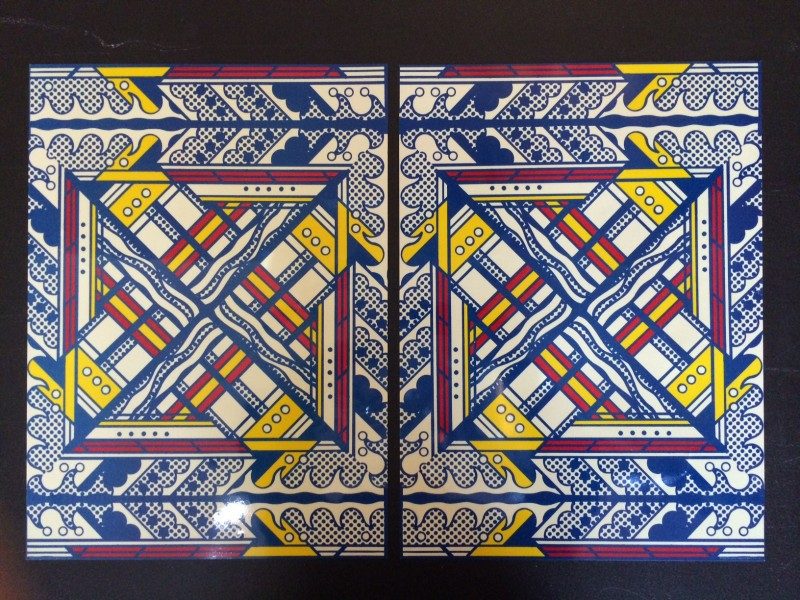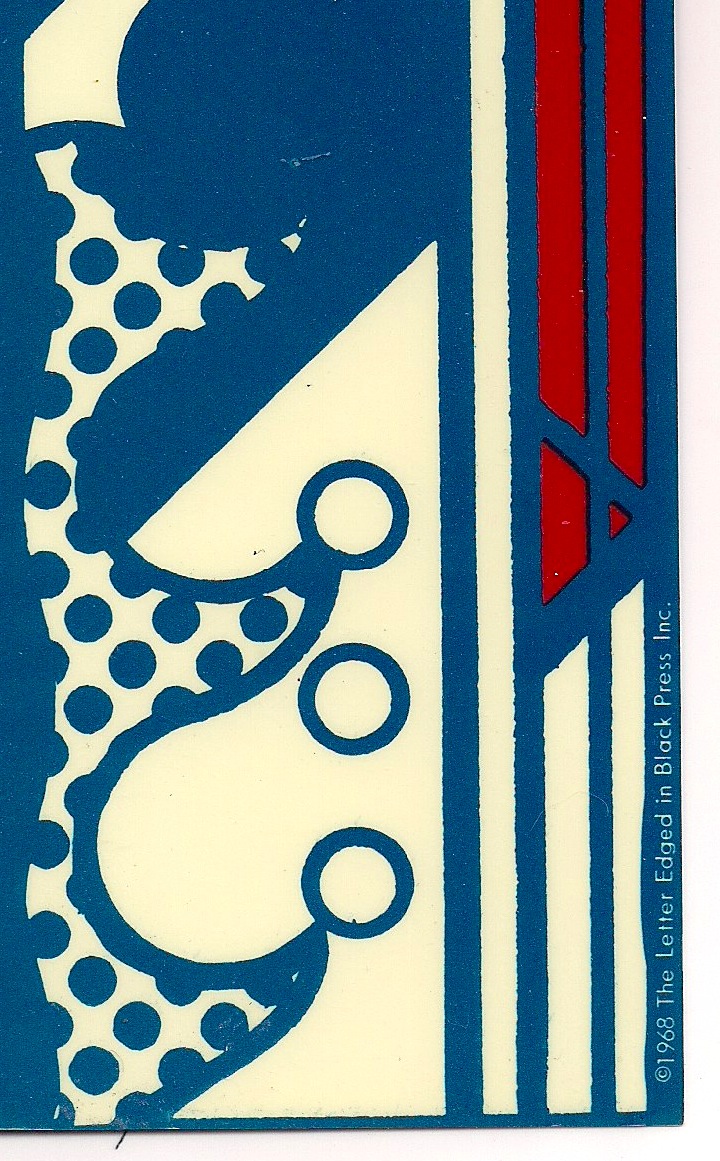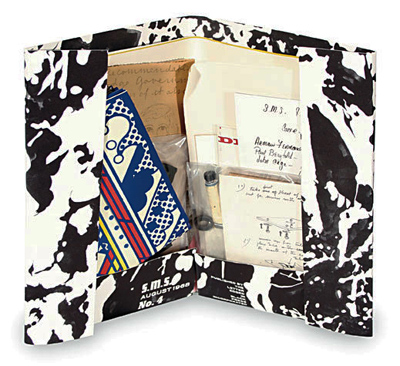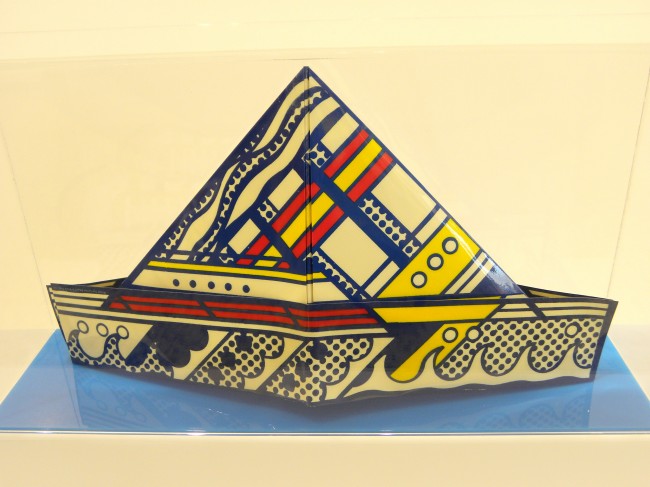SOLD. Roy Lichtenstein (1923-1997) New York, USA
Roy Lichtenstein (1923 – 1997) New York, USA, Original Artwork/Plastic Sealed Print, Custom Made for the ‘The Letter Edged in Black Press Inc.’ which was the publisher of the 6 SMS portfolios released over the course of 1968. Initiated by American Surrealist William Copley, SMS (an abbreviation for ‘Shit Must Stop’) was a collective experience based around a loft on Manhattan’s Upper West Side. Unsigned. See photo of more detail.
One unfolded Lichtenstein plastic lithograph from 1968. Offset lithograph in yellow, red and blue, printed on both sides of a thin, white plastic sheet, sandwiched in transparent plastic. Printed at Omega Graphics, New York, in collaboration with Bernard Reitkopf, and published by the Letter Edged in Black Press. The item is identical on front and back.
14 x 19 inches each.
Condition: has some creases, otherwise, good conditon.
SOLD.
TITLE
S. M. S. (Shit Must Stop) View record in Reed Digital Collections
PUBLICATION
New York City, A Letter Edged in Black Press, 1968
LIBRARY CALL #
P&D NX1 .S12 (1-6) View Reed library catalog record
DESCRIPTION
6 volume Journal/Magazine
S. M. S. #1
COLOPHON
Irving Petlin: Little Box of Earthquake and Cotton, Cover Design, Colored Ink on Heavy Paper, 11 x 14 inches
Su Braden: Project for a Bridge, Ink on folded vellum, 6 1/4 x 6 1/4 inches
James Lee Byars: Black Dress, Printed photograph on tissue envelope, containing Black Tissue Dress, 10 x 10 inches
Christo: Store Front, Mylar and Board construction, 10 3/4 x 6 3/4 inches
Walter de Maria: Chicago Project, Sketches, photograph, and correspondence, 12 x 9 inches
Richard Hamilton: A Postal Card for Mother, Accordion folded photographs, 5 x 8 inches (variable)
Kaspar Koening: My Country ‘Tis of Thee: West Germany, 1968 (four views), Four photographs with hand drawn accents, paper envelope, 6 x 6 inches
Julien Levy: Pharmaceuticals, Prescription pad and empty pill casings, 5 1/4 x 5 1/4 inches
Sol Mednick: Hottentot Apron, printed photograph on paper, 20 x 27 1/2 inches
Nancy Reitkopf: Luggage Labels, six stickers, 8 x 5 1/4 inches Variable
La Monte Young & Marian Zazeela: Two Propositions in Black, calligraphic notes on folded paper, 10 x 24 inches
S. M. S. #1
NOTES
This first edition of S. M. S. contains eleven different projects from important conceptual artists and theorists working at the time. The packet’s small size determined the scale of the work, and allowed for the contributing artists to work both within and out of their comfort zone. Christo, who is most famous for his large environmental collaborations with his wife Jean-Claude, scaled down his practice in order to create a small sized two-dimensional diorama. Similarly, art critic Julian Levy contributed a list of prescriptions for faux medications, capsules included, for artists he determined in need of treatment. Both of these submissions allow for the artist’s voice to shine through, while still maintaining the integrity of Copley’s project. Unlike the following volumes of S. M. S., this first edition reads more like a journal or publication due to the mostly flat nature of the submissions. The following issues seem even more interactive, including games and toys, instead of purely visual stimuli.
S. M. S. #2
COLOPHON
Marcel Duchamp: Cover, Record, remove to play, 11 x 7 inches closed
Nicolas Calas: Cynocephalus & Co., Silkscreen on Mylar, 18 3/4 x 6 1/2 inches
Bruce Conner: Legal Tender, green and black ink on paper, 6 1/8 x 2 5/8 inches
Marcia Herscovitz: Ten Collages, ten photo collages printed front and back, 6 x 4 1/2 inches (variable)
Alain Jacquet: Three Color Seperations, silkscreen on Mylar, 9 1/4 x 6 3/4 inches
Ray Johnson: A Two-Year-Old Girl Choked to Death Today on an Easter Egg, three photographs printed on a single sheet of paper, 10 3/4 x 6 5/8 inches
Lee Lozano: Thesis (All Men are Hardly Created Equal), illustrated bound notebook with ribbon, 3 x 4 3/4 inches
Meret Oppenheim: The Mirror of Genoveva, debossed print, 10 x 6 3/4 inches
Bernard Pfreim: A Proposed Comic Section for the New York Times, full sized comic spread, 24 x 32 inches (six pages)
George Reavey, Farewell to Faust, poem printed on tissue encased in silkscreened cardstock, 6 3/4 x 37 inches
Clovis Trouille: Album, photo album containing 16 paintings, 11 x 6 1/2 inches
S. M. S. #2
NOTES
This second issue of S. M. S. seems more experimental than the first. The cover, designed by chairman of DADA, Marcel Duchamp, is a white folder with a playable record album attached to the front. Printed on the record itself is ESQUIVONS LES ECCHYMOSES DES ESQUIMAUX AUX MOTS EXQUIS, which roughly translates to “dodge the Eskimo bruises with exquisite words,” but functions as a sort of French tongue twister. Duchamp seems to be playfully addressing the restrictions inherent in more traditional portfolio design in order to redefine this practice. The record has aesthetic appeal, but it similarly has far greater use value than the first issue’s front cover, which was a reproduction of a painting. Another particularly provocative work in S. M. S. #2 is Bruce Connor’sLegal Tender. Connor mimics the design of American currency with his stack of eighteen “dollar bills,” which seem more reminiscent of Monopoly money than American legal tender. This element allows for the whole issue to feel like a game, as if you could trade Connor’s money for something more valuable.
S. M. S. #3
COLOPHON
John Battan: Cover Design, six panel painting, 11 x 14 inches
Aftograf: Poems, two bound albums, 5 1/2 x 8 inches
Enrico Baj: Glove, latex glove in pink tissue and plastic sleeve, 10 1/2 x 6 3/4 inches
William Bryant: Clouds, 18 pieces of sheet music, 9 x 12 inches
Dick Higgins: Ode to London, silkscreen on Mylar, 11 x 6 3/4 inches
Joseph Kosuth: Four Titled Abstracts, four folded black sheets encased in black envelope, 10 1/4 x 10 1/2 inches
Ronnie Landfield: Two Drawings, colored ink on paper, 11 x 6 3/4 inches
Roland Penrose: Bush in Hand, die-cut heavy paper construction, 10 3/4 x 7 inches
Man Ray: The Father of Mona Lisa, readymade, 10 3/4 x 6 3/4 inches
H.C. Westermann: Correspondence, four letters tied with pink ribbon, 4 1/4 x 9 1/2 inches
Hannah Weiner: Signal Flag Poems, two folded brochures. Also included: Long Poem for Roy Lichtenstein, and Pinwheel for Chance Poetry, 7 3/4 x 6 3/4 inches
Terry Riley: Poppy No-goods All Night Flight (The First Ascent), two cassette tapes in black boxes, cover design by Riley’s daughter Colleen at age 9.
S. M. S. #3
NOTES
This third edition contains the widest variety of objects, which makes it feel most like finding hidden treasure. It features two Terry Riley cassettes, four pieces of mail from H.C. Westermann seemingly addressed to the reader, and even an original Man Ray readymade. Terry Riley, who is famously known for his innovative avant-garde musical compositions, contributed two beautifully packaged cassettes, which feel like gifts in their own right. H.C. Westermann, who is known for his playful line drawings, mailed four drawings to William Copley, who reproduced them to an exact degree in this issue. In the sealed envelopes are four proposals, with Westermann’s own notes included. Opening these letters feels as though we are receiving mail from Westermann ourselves, which seems to have been Copley’s intention by including in the issue exactly what he received from Westermann.
S. M. S. #4
COLOPHON
Robert Stanley: Cover Design, black and white abstract painting, 11 x 14 1/2 inches
Arman: Tortured Color, paint tube in plexiglass vice
Paul Bergtold: Concept Bergtold, pink tissue folio containing two Xerox compositions, 11 x 8 1/2 inches
John Cage: Diary: How to Improve the World (You Will Only Make Matters Worse) continued 1968, 20 page booklet with silkscreen on Mylar cover, 7 1/2 x 5 1/2 inches
Hollis Frampton: Phenakistiscope, paper disc with photographs, 7 inches in diameter
On Kawara: 100 Year Calendar, calendar printed on single sheet of oil cloth
Roy Lichtenstein: Folded Hat, vinyl hat construction, 7 1/4 x 14 inches
Lil Picard: Burned Bow Tie, burned bow tie, 7 x 3 1/2 inches
Domenico Rotella: 6 Prison Poems, collection of poems written on cigarette packs and a postcard, 9 1/2 x 6 1/2 inches (variable)
Robert Watts: Permanent Parking Decal, sticker, 6 3/4 x 6 3/4 inches
Princess Winifred: Asylum Manuscripts, compositions on five brown paper towels, 9 1/4 x 9 1/2 inches
La Monte Young: Drift Study 4:37:40-5:09:50 5 VIII 68, cassette tape, 5 x 5 inches
Marian Zazeela: Cover design and packaging for Young’s cassette, 5 x 5 inches
S. M. S. #4
NOTES S. M. S. #4 seems slightly more esoteric than the previous three issues. Each piece is laden with a conceptual mythology that can be thoroughly investigated or just taken at face value, which seems a great leap from the playful nature of the first few issues. A particularly interesting work from S. M. S. #4 is Lil Picard’s burned bowtie. Each bowtie was hand burned, thus each number in the edition is slightly varied. The maroon and white polka dotted tie first appears as a joyful addition, but the burned edges seem a quite poignant dissenting argument. Other interesting works are Rotella’s prison poems, which were clandestinely written on scraps of paper during a five-month prison sentence in Rome, Italy. The tactile nature of the poems as works of art in their own right seems important for the overall impact of the piece, which elegantly replicates a minute part of Rotella’s prison experience.
S. M. S. #5
COLOPHON
Congo: Cover Design, painted by Congo the Chimpanzee, 11 x 14 inches
William Anthony: Custer’s Last Stand, inside cover design, 11 x 14 inches
Wall Batterton: Splendid Person, photograph and text on cardstock, 9 7/8 x 6 5/8 inches
William Copley: The Barber’s Shop, dossier, correspondences and newspaper clippings, 10 x 6 3/4 inches (closed)
Edward Fitzgerald: 24 Still Lives, 24 color stamps, 10 3/8 x 7 3/8 inches
Neil Jenney: Bucks American, four drawings stapled together, 8 3/4 x 6 1/2 inches
Angus MacLise: The Inner Pages, 20-page booklet, 6 3/4 x 8 3/4 inches
Bruce Nauman: Footsteps, recorded magnetic tape wound around instructions for use, 2 1/2 x 10 3/4 inches (folded)
Yoko Ono: Mend Piece for John, box containing materials and instructions for mending a broken cup, 6 1/8 x 6 1/4 inches (contained)
Mel Ramos: Candy, ink on heavy paper, 10 7/8 x 13 7/8 (Unfolded)
Robert Rohm: Cut Corners, ink on heavy paper and three foldable structures, 6 3/4 x 10 3/4 inches (variable)
William Schwedler: Against The Grain, three-dimensional assemblage, 10 5/8 x 6 3/4 inches (folded)
Diane Wakoski: The Magellanic Clouds, photographic print impressed with grooves to be played as a record, 6 7/8 x 7 inches
Lawrence Weiner: Turf, stake and String, clear vinyl sticker sheet, 6 1/4 x 8 5/8 inches.
S. M. S. #5
NOTES Unlike the previous issues, S. M. S. #5 doesn’t appear to be projecting a specific sensibility upon the reader, thus making it seem more disparate than the others. This seems to be best exemplified by Yoko Ono’s contribution, entitled Mend Piece for John, which instructs, “Take your favorite cup. Break it in many pieces with a hammer. Repair it with this glue and this poem.” Included is a cardboard box containing a ribbon, plastic bag, instructions, a poem, and a tube of glue. Although Ono created this piece years before the Beatles disbanded, it seems almost premonitive of the years to come. Another similarly disparate piece from this issue is the front cover, which was painted by Congo, the chimpanzee, for a study of the creative potential of apes. It has been noted that Congo was the only chimpanzee who appeared to make aesthetic decisions about his painting, and thus could be featured along side these other artists for the issue. Like Ono’s piece, Congo’s painting seems eerily foreboding with its large red and black smears of paint.
S. M. S. #6
COLOPHON
Richard Artschwager: Cover design, ink and coffee stains on heavy paper, 11 x 14 inches
Ed Bereal: Self-Portrait, altered photograph on paper, 16 x 13 1/2 inches
Diter Rot: Chocolate Bar, four prints, blue paper wrapper, (4 3/16 x 3 1/16 inches)
Betty Dodson: Friends, etching in hot pink cellophane, 5 1/2 x 8 inches
Ronoldo Ferri: Neon Construction, die-cut metallic rings, 6 3/4 x 6 3/4 inches (variable)
John Giorno: Chinese Fortune Game, game set, 10 x 6 inches
Toby Mussman: Ten Xerox Sheets, ten Xerox collages
Adrian Nutbeem: Twenty Down, colored card, 5 3/8 x 9 1/4 inches
Claes Oldenburg: Unattended Lunches, pamphlet, 8 1/2 x 5 1/2 inches (folded)
Mischa Petrov: Junior Historical Theatre Playroom Kit, die-cut cardboard toy, 14 x 11 inches
Jean Reavey: Adora, silkscreen document with aluminum envelope, 8 1/2 x 6 1/4 inches
Bernar Venet: Astrophysics, record album with document notes, 7 x 16 3/8 inches (open)
S. M. S. #6
NOTES S. M. S. #6, which is the last issue produced, makes a valorous attempt at preserving the initial integrity of the project. Richard Artschwager’s cover design is a simple image of a black shape reproduced on each surface of the cover, both inside and out, with reproductions of the exact coffee stains he accidentally made when producing the original. By approving of this accident, and reproducing it for the cover, Artschwager, and Copley seem to be making an argument about the place of beauty and mistake in the contemporary art world. The rest of the pieces in this final issue seem to be playful and mischievous manifestations of this same idea, with Adrian Nutbeem’s unsolvable crossword as well as Claes Oldenburg’s Unattended Lunches. The issue also comes with an apology, which reads, “The publishers of the Letter Edged in Black Press, Inc. regretfully announce that this is the last issue of S.M.S. that will appear. We have appreciated your support and hope you will remember our effort with appreciation.” The vague nature of the card supports the mischievous nature of this issue’s contents, while still maintaining the sincerity of the project.




